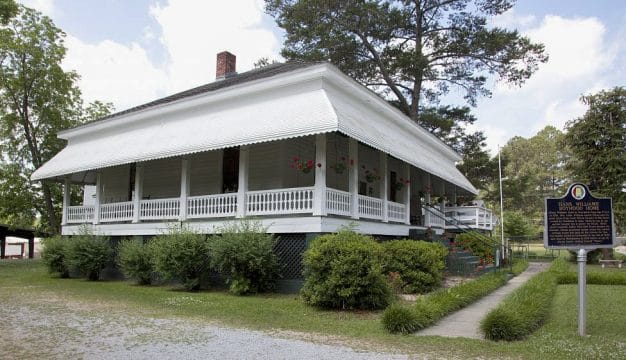Tutwiler’s Spleenwort
 Tutwiler's Spleenwort
Tutwiler's spleenwort, Asplenium tutwilerae, is one of the world's rarest ferns, known only from Havana Glen, Hale County, just south of Moundville. There, the fern grows on a steep eroding slope composed of puddingstone, a type of conglomerate rock, in a unique microclimate. The species is named for Alabama prison reformer, educator, and amateur botanist Julia Strudwick Tutwiler, who discovered the plant in 1873.
Tutwiler's Spleenwort
Tutwiler's spleenwort, Asplenium tutwilerae, is one of the world's rarest ferns, known only from Havana Glen, Hale County, just south of Moundville. There, the fern grows on a steep eroding slope composed of puddingstone, a type of conglomerate rock, in a unique microclimate. The species is named for Alabama prison reformer, educator, and amateur botanist Julia Strudwick Tutwiler, who discovered the plant in 1873.
Tutwiler found the fern while exploring the glen, which is located about five miles from her home. She noted, in an 1873 letter to Daniel Eaton, the editor of the Journal of the Torrey Botanical Club, that she had come upon five ferns that were unlike any others in the area. She thus became the first person to write about this species.
Upon examination, Tutwiler hypothesized that the fern was a hybrid between two species native to Havana Glen: ebony spleenwort (Asplenium platyneuron) and walking fern (A. rhizophyllum). A similar hybrid, named Asplenium ebenoides, had been previously found near Philadelphia, Pennsylvania, where Tutwiler once studied. Her discovery was exciting yet not unexpected because members of the spleenwort family (Aspleniaceae) have long been known to hybridize.
During the century following her discovery, many botanists took the long, arduous trip to Havana Glen to admire this plant, collect specimens, and ponder its origin. One researcher, Margaret Slosson, successfully produced Tutwiler's plant in her laboratory by crossing the two suspected parent species. But in 1896, Alabama Alabama Agricultural and Mechanical College's (now Auburn University) Lucien Underwood travelled to the glen and was surprised to find that the plants were multiplying profusely, unlike any other known hybrid, which are typically sterile. This ease of reproduction raised questions for him about the plant's status as a hybrid. (A mule is a good example of a hybrid animal, the sterile product of a female horse and a male donkey.)
 Tutwiler's Spleenwort
In 1930, Edgar Wherry of the University of Pennsylvania noted something even stranger: One of the hybrid's purported parents, the walking fern, had completely disappeared from Havana Glen, yet many young, supposedly hybrid plants thrived at the site. This situation would be the equivalent of finding many mules and horses at Havana Glen but no donkeys. In 1954, Herb Wagner, cytologist and spleenwort hybrid expert from the University of Michigan, found an explanation for the plant's success. The initially sterile hybrid had doubled its chromosomes, a process known as polyploidy, during its evolutionary history—a common occurrence in plant evolution—making its offspring completely fertile and independent of the parent species. Thus, the Havana Glen spleenwort had become a separate, reproductively viable species, following an evolutionary track all of its own.
Tutwiler's Spleenwort
In 1930, Edgar Wherry of the University of Pennsylvania noted something even stranger: One of the hybrid's purported parents, the walking fern, had completely disappeared from Havana Glen, yet many young, supposedly hybrid plants thrived at the site. This situation would be the equivalent of finding many mules and horses at Havana Glen but no donkeys. In 1954, Herb Wagner, cytologist and spleenwort hybrid expert from the University of Michigan, found an explanation for the plant's success. The initially sterile hybrid had doubled its chromosomes, a process known as polyploidy, during its evolutionary history—a common occurrence in plant evolution—making its offspring completely fertile and independent of the parent species. Thus, the Havana Glen spleenwort had become a separate, reproductively viable species, following an evolutionary track all of its own.
To commemorate the independence and separate nature of the Havana Glen population, the plant was renamed Asplenium tutwilerae in 2007. Because of its rarity and unique habitat needs, statewide conservationists and experts with the Alabama Plant Conservation Alliance established a committee and task force, headed by the Birmingham Botanical Gardens, to oversee efforts to propagate and maintain populations of the plant and to protect its habitat in Havana Glen and to list Tutwiler's spleenwort as an endangered species.
Further Reading
- Davenport, L. J. “Miss Julia’s Fertile Fern.” Alabama Heritage 86 (Fall 2007): 44, 46.
- Eaton, Daniel C. “Asplenium eb[e]noides.” Bulletin of the Torrey Botanical Club 4 (1873): 17-18.
- Keener, Brian R., and L. J. Davenport. “A New Name for the Well-Known Asplenium (Aspleniaceae) from Hale County, Alabama.” Journal of the Botanical Research Institute of Texas 1 (2007): 103-108.
- Wherry, Edgar T., and Harry W. Trudell. “The Asplenium ebenoides Locality near Havana, Alabama.” American Fern Journal 20 (1930): 30-32.



